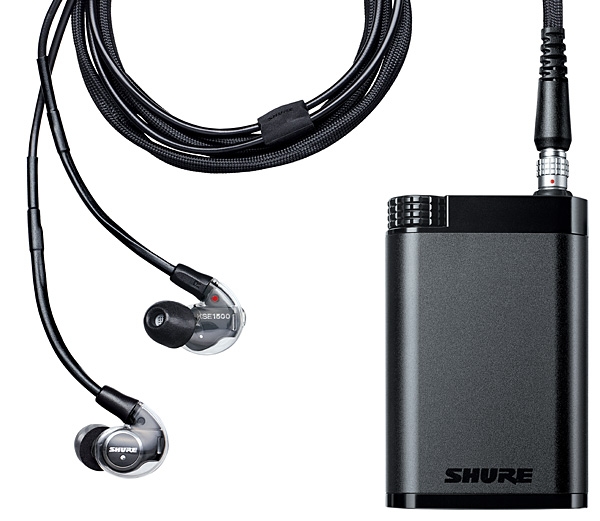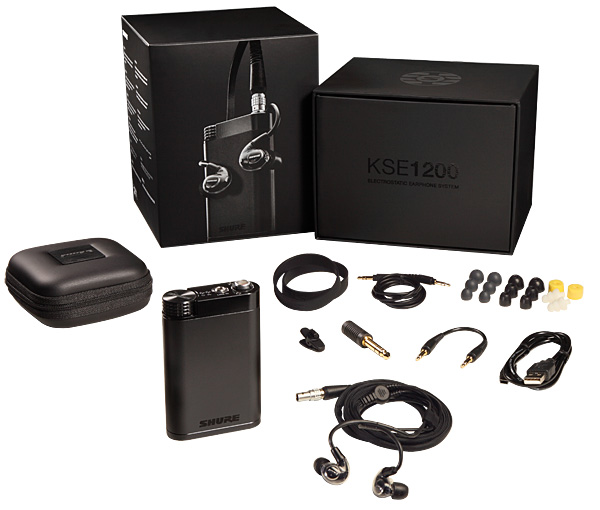| Columns Retired Columns & Blogs |
Don't forget to dry your ears out after a shower.
Remember the 60's ECT (electroconvulsive therapy)
Cheers George

Technology
Like the KSE1500s', the KS1200SYSes' drive-units feature a virtually massless diaphragm suspended between two back plates, with a 200V polarizing voltage across the plates. The dedicated amplifier feeds the earpieces both the polarizing voltage and a high-voltage (±200V) audio signal via a Kevlar-shielded cable terminated with a six-pin Lemo connector. The resultant soundwaves are coupled to the user's eardrum via a small tube. A detachable sleeve slides over the tube, seals the ear canal, and provides significant isolation from external sounds. The supplied Fit Kit includes five pairs of sleeves, made of Soft Flex rubber in small, medium, and large, as well as sleeves of Soft Foam and Triple-Flange sleeves.
The black-finished amplifier is about the size of a pack of playing cards. On one end are the Lemo connector, an analog line-in jack, and a knurled volume knob that also acts as the power switch. There are two LEDs. The one farthest from the jacks glows various colors: green indicates that the amplifier is charged and powered on, red that the battery needs charging, and amber that the amp is charging via the 5V Micro-B USB port on its other end. The second LED displays the status of the analog input signal: green indicates that the amplifier is receiving audio signal, amber that it's receiving input at the ideal level, red that the input level is too high. A slide switch next to the USB port can be used to reduce the input level by 10dB, if necessary.
The KSE1500 has a four-band digital equalizer. The analog-only KSE1200SYS amplifier offers no EQ, though its manual says that the ShurePlus Play app, available for iOS and Android smartphones, has a similar four-band equalizer. (This app only became available after this issue went to press.)
Use
Because the KSE1500 amplifier has inputs and outputs on opposite ends of its case, it can't comfortably fit in a shirt or jacket pocket. With both input and output on the same end, this was not a problem with the KSE1200 amplifier, and its smaller size—slightly narrower and almost an inch shorter than the KSE1500—makes it more pocket-friendly.

The short lengths of cable connecting each KSE1500 earpiece to the yoke are stiffer and heavier than those of normal in-ear monitors (IEMs), which makes inserting the earpieces tricky. The same sections of the KSE1200s' cables seem more flexible than I remembered the KSE1500s' being, and while the Kevlar-armored section of the cable still tended to pick up clothing noise, this wasn't a problem when I sat still. The earpieces are comfortable—listening sessions could last an entire evening without my ears becoming sweaty. Sound isolation with the largest-diameter sleeves was excellent, the external world not intruding on my listening—one night, I almost missed dinner!
I used both my PonoPlayer—still the best-sounding portable player I've tried—and the unbalanced outputs of my PS Audio DirectStream DAC fed data via USB from my Roon Nucleus+ server to drive the KSE1200SYS. With the Pono I used either of the two male-to-male 3.5mm cables (they're 6" and 36" long) supplied with the Shure. With the PS Audio I used a 2m-long, RCA-to-3.5mm AudioQuest Coffee cable. With the Pono set to fixed output level, its output lit the signal LED red on peaks; rather than use the Shure's 10dB pad, which resulted in too much attenuation, I adjusted the volume to three-fourths of full; the LED then turned from green to amber only on peaks. With the PS Audio, the pad again reduced the gain too much, so I lowered the DirectStream's volume from "100" to "84"—ie, a reduction in level of 8dB—which just turned the LED amber on peaks. But the difference in source volume between amber (okay) and red (audible overload) was relatively small.
Sound
A problem with armature-based IEMs, such as my Ultimate Ears 18 Pros, is that their vibrating reeds start to run out of excursion with high levels of low-frequency tones, producing "doubling" (second-harmonic distortion). This was not the case with either the KSE1500 or KSE1200SYS earpieces, which played the low-frequency, 1/3-octave warble tones on my Editor's Choice (CD, Stereophile STPH016-2) cleanly and with full weight down to 32Hz, provided the sleeves were making good seals with my ear canals. The combination of low-frequency clarity and weight in "Happiness Is Easy," from Talk Talk's The Colour of Spring (DSD64 file ripped from SACD, EMI 591452), made the sparse interjections from Danny Thompson's double bass and Alan Gorrie's electric bass sound suitably forceful. No, in terms of low-frequency weight, the in-ear Shures still couldn't match my long-term headphone reference, Audeze's LCD-Xes, driven in balanced mode by Ayre Acoustics' EX-8 integrated amplifier. However, the over-ear LCD-Xes weigh my head down after the first couple of hours; the lightweight Shures remained comfortable throughout far longer listening sessions.

Conventional IEMs also start to roll off in the top octave. By contrast, the Shure KSE1200s's high frequencies had excellent treble extension. The clean, clear highs in "A Hard Rain's A-Gonna Fall," from Bill Frisell's classic East/West (16-bit/44.1kHz ALAC ripped from CD, Nonesuch 7559-79863-2), allowed the cymbals to breathe, while the resolution of the subtle reverb on Frisell's electric guitar in the opening was simply delicious.
The Shure's midrange offered superb clarity—something that, with hindsight, I hadn't made enough of in my review of the KSE1500. The final recording I made at the Santa Fe Chamber Music Festival, in 1998, featured Mozart's Piano Quartet 1 in g, K.478, with Pinchas Zukerman on violin, Cynthia Phelps on viola, Eric Kim on cello, and Marc Neikrug on piano. In the slow movement of what is really a miniature piano concerto (16/44.1 WAV, master from Bravo!, Stereophile STPH014-2), the Shure's clean, uncolored midrange allowed the piano to sound as brilliant as it had when I made the recording. The KSE1200's clarity also placed the musicians solidly within the acoustic of Santa Fe's St. Francis Auditorium, which I'd subtly reinforced with some matching, Lexicon-derived artificial ambience (footnote 1).
I'd written that the KSE1500s' balance was a touch bright, but I didn't find that to be the case with the KSE1200s. "Backhand Rainbows Cadillac," from Bruce Hornsby & the Noisemakers' Free Noise: 2009/11/01 St. Paul, MN (16/44.1 FLAC, download from www.brucehornsbylive.com/catalog.aspx), with its nod to Thelonious Monk at the beginning, has an upfront recorded balance, but the KSE1200 dealt gracefully with it, allowing me to dig deep into the superb music-making. Again, the earpieces' extended, weighty low frequencies allowed the bass guitar and kick drum to appropriately underpin the craftsmanship of these musicians playing at the top of their game. And while the performance of this song on the Noisemakers Summer 2007 download from the same site is only a 256kbps MP3, the clarity and lack of compression offered by the Shure electrostatics allowed the music to communicate most effectively.
Summing Up
I concluded my review of Shure's KSE1500 in November 2016 by saying that it was the finest-sounding in-ear monitor system I had experienced. Since then I have reviewed the Audeze LCDi4, which uses external planar-magnetic diaphragms and costs $2495. Those superb in-ear headphones have long since been returned to Audeze, so I couldn't compare them with the Shures. However, I noted in my review that the LCDi4s had almost no isolation from external sound, a somewhat polite balance, and less low-frequency bloom than Audeze's LCD-X headphones. Shure's KSE-1200SYS IEMs certainly don't sound too polite, but their extended highs lack any hint of brightness or brittleness, and their superbly natural midrange and well-defined low frequencies make them a must-hear product. Strongly recommended.

Don't forget to dry your ears out after a shower.
Remember the 60's ECT (electroconvulsive therapy)
Cheers George

That would qualify as ..... 'shockingly realistic' ...... sound reproduction :-) ........

..... or ... 'that is truly shocking' ..... listening experience :-) .........
